Fort Street Mall: Shopping
Honolulu’s Fort Street has been the site of numerous important organizations of all kinds: schools, theaters, restaurants, churches, barber shops and beauty parlors, and an abundance of varied businesses both large and small. But it was best known during the first half of the twentieth century as the center of shopping in the Hawaiian Islands, with the widest selections at a range of prices in many stores. The most famous and influential retail businesses in Hawaii got their starts here, spread to other branch locations, then eventually disappeared entirely. As it happens, this was the fate of Fort Street itself as well, since today shopping is virtually extinct there.
While there are countless stories to tell of Fort Street’s history in its entirety, this booklet focuses on the rise and fall of retailing in this location, to remind those who never experienced this of what once existed and is now mostly forgotten.
While there are countless stories to tell of Fort Street’s history in its entirety, this booklet focuses on the rise and fall of retailing in this location, to remind those who never experienced this of what once existed and is now mostly forgotten.

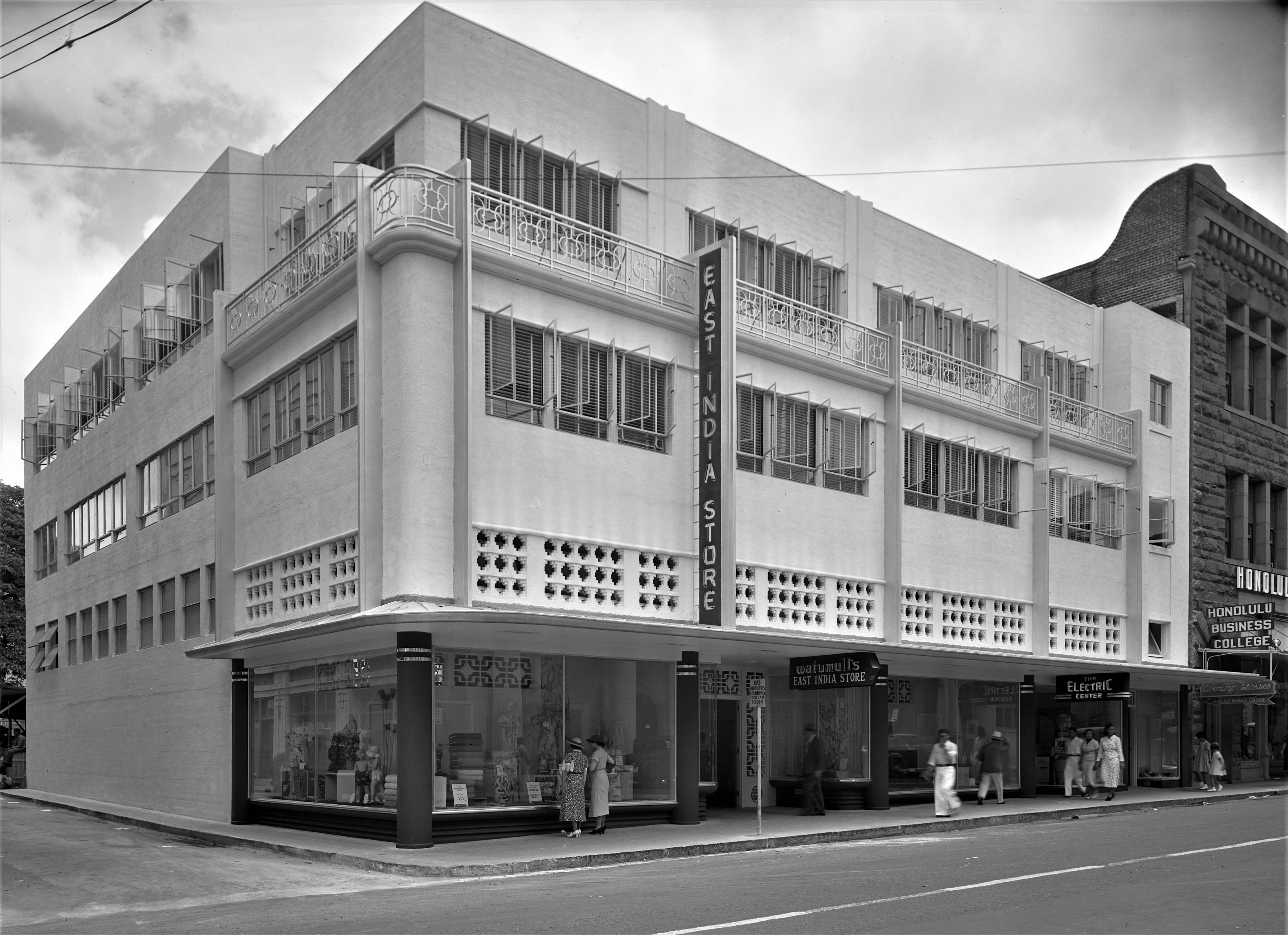






PANELISTS
 DeSoto Brown is the Bishop Museum Historian and Curator for the Archives, where he has been employed for over 35 years. He shows and interprets materials from the Archives collection in lectures, interviews, and online presentations for both education and entertainment.
DeSoto Brown is the Bishop Museum Historian and Curator for the Archives, where he has been employed for over 35 years. He shows and interprets materials from the Archives collection in lectures, interviews, and online presentations for both education and entertainment.DeSoto’s talk story ︎︎︎
 William Chapman is Dean of the School of Architecture, University of Hawai‘i at Mānoa. Educated at Columbia (M.S. in Historic Preservation, 1978) and at Oxford University in England (D.Phil. in Anthropology, 1982), he specializes in architectural recording, the history of historic preservation, and materials conservation.
William Chapman is Dean of the School of Architecture, University of Hawai‘i at Mānoa. Educated at Columbia (M.S. in Historic Preservation, 1978) and at Oxford University in England (D.Phil. in Anthropology, 1982), he specializes in architectural recording, the history of historic preservation, and materials conservation.
 Jack Gillmar grew up in Waikiki when shopping on Fort Street was where it was at! He has an accurate visual memory of Fort Street and the surrounding city from 1948. Shopping was at Kress and Liberty House on Fort and at Yat Loy’s around the corner on King. The dentist was on Bethel, the doctors in the Alexander Young Hotel building. The military was “occupying” Hotel Street with its bars, brothels and arcades.
Jack Gillmar grew up in Waikiki when shopping on Fort Street was where it was at! He has an accurate visual memory of Fort Street and the surrounding city from 1948. Shopping was at Kress and Liberty House on Fort and at Yat Loy’s around the corner on King. The dentist was on Bethel, the doctors in the Alexander Young Hotel building. The military was “occupying” Hotel Street with its bars, brothels and arcades.  Todd J. Hassler, AIA, NCARB, LEED AP is a partner at Peter Vincent Architects (PVA). He earned his Associate of Arts Degree in Architectural Technology from SUNY Orange and a five-year Bachelor of Architecture Degree from the New York Institute of Technology.
Todd J. Hassler, AIA, NCARB, LEED AP is a partner at Peter Vincent Architects (PVA). He earned his Associate of Arts Degree in Architectural Technology from SUNY Orange and a five-year Bachelor of Architecture Degree from the New York Institute of Technology.
 Karolyn Jones is a third-year undergraduate student at UH-Mānoa where she is majoring in Environmental Design. School takes up most of her time, however Karolyn still finds moments to float on her paddle board and read about World War II.
Karolyn Jones is a third-year undergraduate student at UH-Mānoa where she is majoring in Environmental Design. School takes up most of her time, however Karolyn still finds moments to float on her paddle board and read about World War II.CHRISTMAS AT FORT STREET MALL



WINDOW SHOPPING

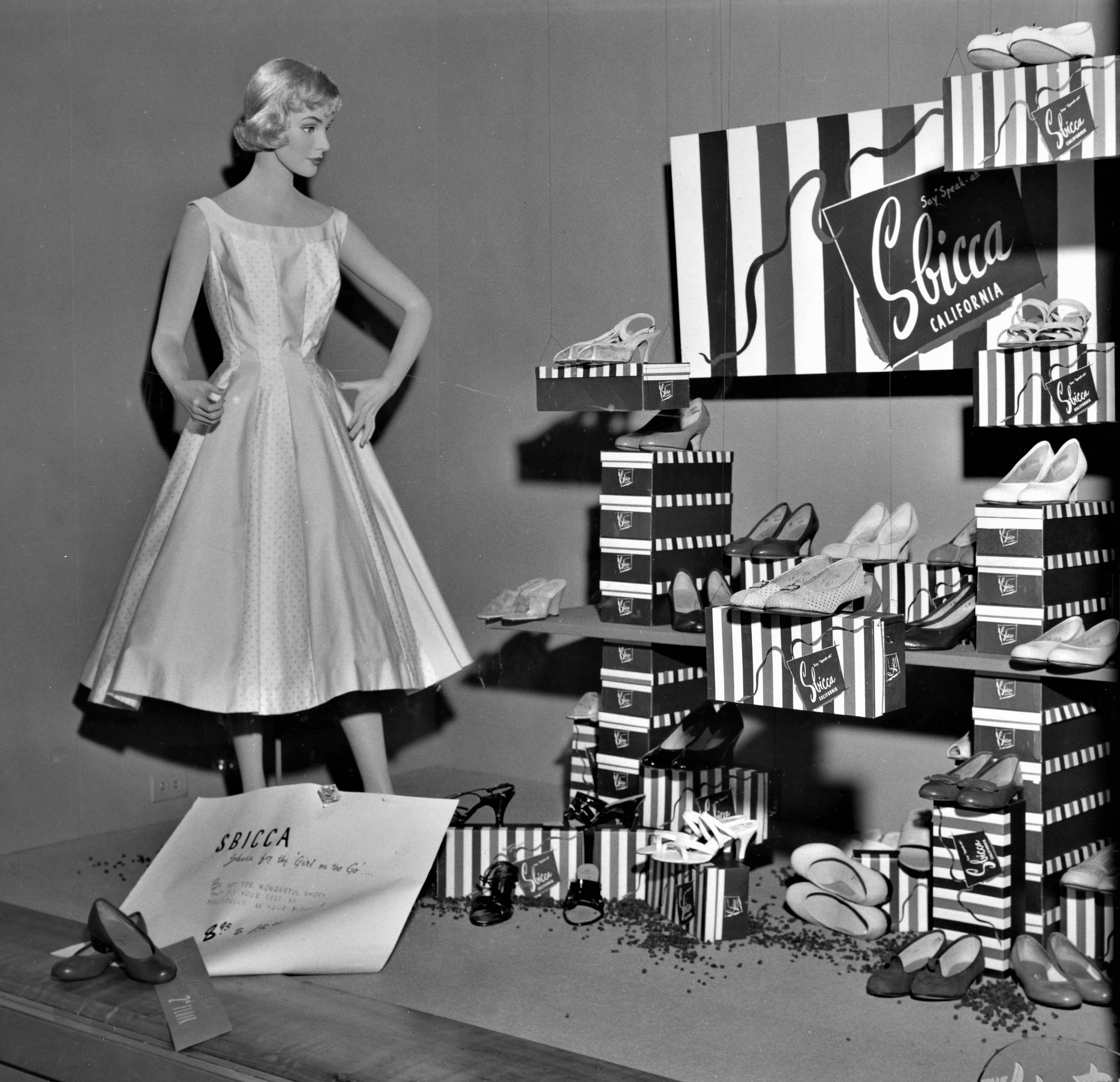

The multiple stores along Fort Street used large display windows to attract the attention of passing pedestrians, in hopes of luring them inside to make purchases. Even without buying anything, women in particular enjoyed “window shopping” by just viewing what was for sale. This could happen even at night, when retailers were closed, after windows began to be illuminated by electric lights.
Shown here are, first, innumerable bottles of Welch’s Grape Juice at the Henry May & Co. grocery store in 1911, fashionable Sbicca shoes for the “Girl On The Go” at Liberty House in the 1950s, and fine pottery, glassware and even a few modern electric appliances at the E. O. Hall store around 1915. (L. E. Edgeworth and unknown photographer, Bishop Museum Archives)
Shown here are, first, innumerable bottles of Welch’s Grape Juice at the Henry May & Co. grocery store in 1911, fashionable Sbicca shoes for the “Girl On The Go” at Liberty House in the 1950s, and fine pottery, glassware and even a few modern electric appliances at the E. O. Hall store around 1915. (L. E. Edgeworth and unknown photographer, Bishop Museum Archives)
LIBERTY HOUSE
In American cities, department stores were major and influential retailers. In addition to the Fair and Ritz department stores on Fort Street, the leader in Honolulu was Liberty House. It had begun as the Hackfeld Co. in August 1850, then underwent two name changes to first B. F. Ehlers & Co., then Liberty House in 1918. It expanded into a number of branches starting in the 1930s, as listed on this credit card from about 1960. After being bought out by a national corporation, it became Macy’s in 2001. (Credit
card, DeSoto Brown Collection)
Liberty House was the premier store for women’s fashions. Here are two Fort Street display windows demonstrating this; the first from 1912, and the second from 1940, promoting fabrics in “Trade Wind Colors”. (L. E. Edgeworth, William Pitchford; Bishop Museum Archives)
The original downtown location for Liberty House was at the corner of King and Fort Streets. The business grew from its original building on the right into the Odd Fellow’s Hall in the center in 1924. It then occupied a new structure on King Street (out of view on the left) in 1929, and finally claimed the small building on the corner in about 1960. These diverse structures were visually combined together with an overall smooth façade in the ‘50s. This complex was demolished around 1980 and the replacement building in the same location today is now a Walmart. (L. E. Edgeworth, Bishop Museum Archives)
Liberty House was the premier store for women’s fashions. Here are two Fort Street display windows demonstrating this; the first from 1912, and the second from 1940, promoting fabrics in “Trade Wind Colors”. (L. E. Edgeworth, William Pitchford; Bishop Museum Archives)
The original downtown location for Liberty House was at the corner of King and Fort Streets. The business grew from its original building on the right into the Odd Fellow’s Hall in the center in 1924. It then occupied a new structure on King Street (out of view on the left) in 1929, and finally claimed the small building on the corner in about 1960. These diverse structures were visually combined together with an overall smooth façade in the ‘50s. This complex was demolished around 1980 and the replacement building in the same location today is now a Walmart. (L. E. Edgeworth, Bishop Museum Archives)



MCLNERNY’S


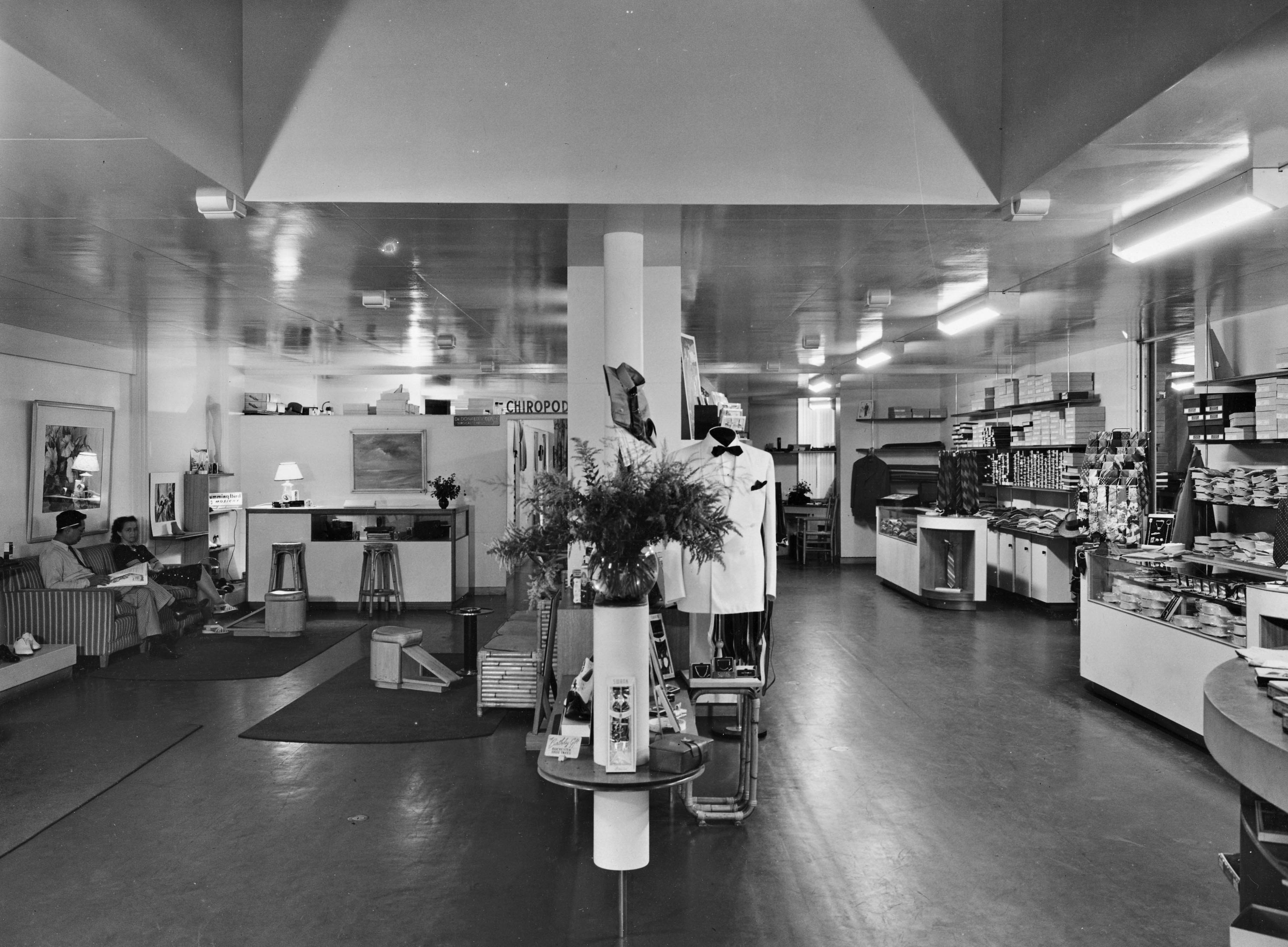
A major name in Honolulu clothing stores was McInerny, founded in 1850. For years there were two McInerny stores on Fort Street, each run by one of two twin brothers.
The store at Merchant and Fort Streets, shown here on the left in 1945, sold clothing. (Ray Jerome Baker, Bishop Museum Archives; label, DeSoto Brown Collection).
The other store at King and Fort Streets specialized in shoes, seen in 1940. (William Pitchford, Bishop Museum Archives; matchbook, DeSoto Brown Collection)
The McInerny twins died in 1945 and 1947, and in the latter year the two former stores were combined into one in the King Street structure. The existing building from 1900 was very extensively improved and modernized, as shown in these two photos from 1913 and 1953. It was demolished in 1968 as part of the creation of the Fort Street Mall and the site remains today as open space. (1913, L. E. Edgeworth;1954, Irving Rosen, both Bishop Museum Archives).
The store at Merchant and Fort Streets, shown here on the left in 1945, sold clothing. (Ray Jerome Baker, Bishop Museum Archives; label, DeSoto Brown Collection).
The other store at King and Fort Streets specialized in shoes, seen in 1940. (William Pitchford, Bishop Museum Archives; matchbook, DeSoto Brown Collection)
The McInerny twins died in 1945 and 1947, and in the latter year the two former stores were combined into one in the King Street structure. The existing building from 1900 was very extensively improved and modernized, as shown in these two photos from 1913 and 1953. It was demolished in 1968 as part of the creation of the Fort Street Mall and the site remains today as open space. (1913, L. E. Edgeworth;1954, Irving Rosen, both Bishop Museum Archives).
WATUMULL’S
The first members of the Watumull family arrived in Honolulu from India in the early 1900s and went on to establish a local chain of retail stores, focusing on clothing. The proof of the business’s success came with the opening of the new Watumull’s East India Store on Fort Street in 1937. This modern building featured a very up-to-date and elegant interior. Later retail branches included the Leilani Gift Shop, also on Fort Street. Today the business has moved exclusively into real estate ownership and development.
(Photos: On Char, Bishop Museum Archives; ad, DeSoto Brown Collection).
(Photos: On Char, Bishop Museum Archives; ad, DeSoto Brown Collection).



BERGSTROM MUSIC CO.
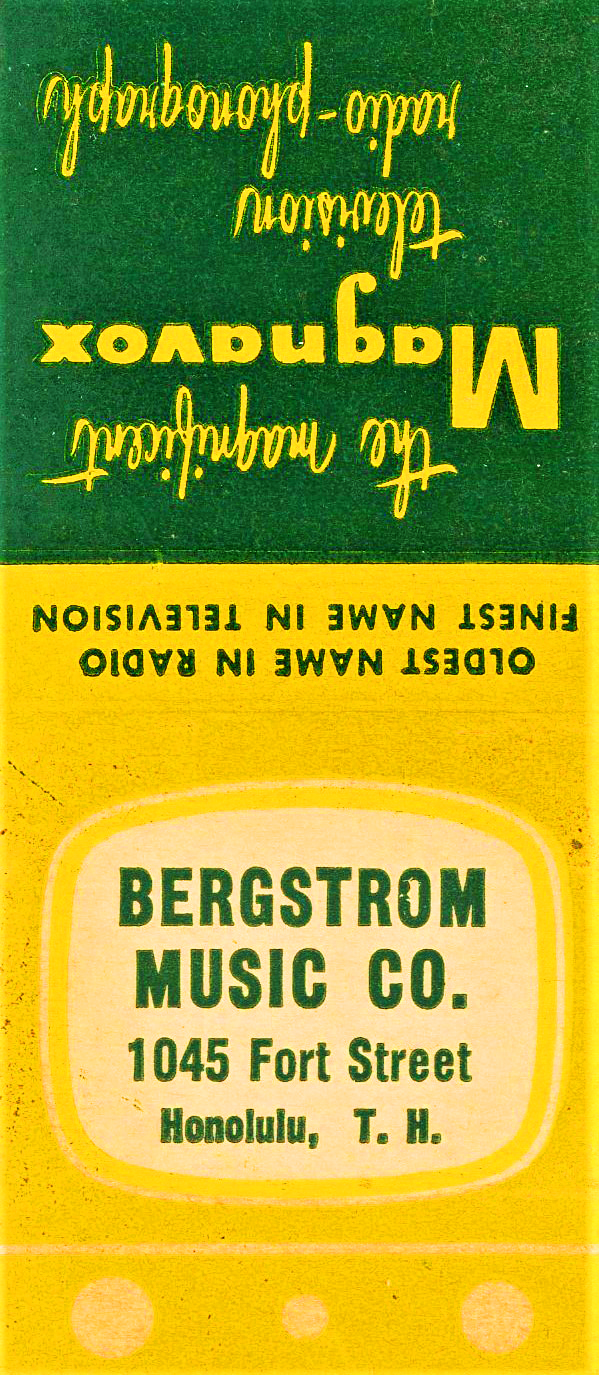

A variety of devices are on sale in Fort Street’s Bergstrom Music store in December 1908. A mechanical upright piano is on the left, which would have been operated by a seated person pumping on the two foot pedals. On the right are the large trumpet-shaped horns through which music would have been heard from the players of recorded cylinders or discs. The “Aloha Oe” sheet music was published by Bergstrom around 1912, and the matchbook advertises Magnavox televisions; TV broadcasting started in Hawaii in December 1952. (L. E. Edgeworth, Bishop Museum Archives; sheet music and matchbook, DeSoto Brown Collection)
SHOE SHOPPING
Fort Street was probably the best place to shop for shoes for many years. Here are a few of the shoe stores once located there.
Regal Shoes was at the corner of Hotel and Fort Streets and is shown here both inside and outside in 1913-1914. (L. E. Edgeworth, Bishop Museum Archives)
The national chain Leed’s Shoes opened its new building at 1056 Fort Street on September 1, 1955. This was one of its 270 locations at that time. (Irving Rosen, Bishop Museum Archives)
The Manufacturer’s Shoe Store occupied two Fort Street sites, at 1051 (seen on the two advertising matchbooks) and then 1041, which was remodeled and modernized in 1954. (Irving Rosen, Bishop Museum Archives; matches, DeSoto Brown Collection)
Regal Shoes was at the corner of Hotel and Fort Streets and is shown here both inside and outside in 1913-1914. (L. E. Edgeworth, Bishop Museum Archives)
The national chain Leed’s Shoes opened its new building at 1056 Fort Street on September 1, 1955. This was one of its 270 locations at that time. (Irving Rosen, Bishop Museum Archives)
The Manufacturer’s Shoe Store occupied two Fort Street sites, at 1051 (seen on the two advertising matchbooks) and then 1041, which was remodeled and modernized in 1954. (Irving Rosen, Bishop Museum Archives; matches, DeSoto Brown Collection)







DUNN’S HAT SHOP


In 1910, fashionable women’s hats were huge and overloaded with various decorations, as the photo of a social gathering of well-to-do women in Honolulu from that time clearly shows. (Bishop Museum Archives)
In the glass case at Dunn’s Hat Shop on Fort Street, diverse items are displayed for potential decorative use for these creations: fabric, ribbons, artificial flowers, and so on. Sadly, the demand for feathers for such hats caused some birds to be hunted to extinction then. (L. E. Edgeworth, Bishop Museum Archives)
In the glass case at Dunn’s Hat Shop on Fort Street, diverse items are displayed for potential decorative use for these creations: fabric, ribbons, artificial flowers, and so on. Sadly, the demand for feathers for such hats caused some birds to be hunted to extinction then. (L. E. Edgeworth, Bishop Museum Archives)
BENSON SMITH DRUG STORE
One of several well-patronized drug stores on Fort Street was Benson Smith, prominently located at the King Street intersection. It was thronged with military personnel during the World War II years in the early 1940s. (Ray Jerome Baker, Bishop Museum Archives; matchbook, DeSoto Brown Collection)
A feature of American drug stores for many years was the soda fountain, which served sandwiches and other foods but was best known for ice cream dishes. This is Benson Smith’s new soda fountain in 1937. (On Char, Bishop Museum Archives)
A feature of American drug stores for many years was the soda fountain, which served sandwiches and other foods but was best known for ice cream dishes. This is Benson Smith’s new soda fountain in 1937. (On Char, Bishop Museum Archives)


FORT STREET TRAFFIC



Busy Fort Street had to contend with streetcars, motor vehicles and pedestrians over the years.
The Honolulu Rapid Transit Co. electric streetcars ran on Fort Street from 1904 to the late 1920s, as seen in the center of this photo from King Street. Notice the policeman directing traffic on the right, in an umbrella-shaded kiosk. (DeSoto Brown Collection)
Fort Street’s congestion led to a one-way traffic pattern being imposed in 1931, with vehicles going mauka. This was switched briefly to the other direction from November 1941 to February 1942. (DeSoto Brown Collection)
On March 1, 1955, traffic again was routed makai. This remained in effect until the start of construction of the Fort Street Mall on June 1, 1968, which permanently ended vehicle access.
Fort Street was often crowded with pedestrians, and careless jaywalking led to injuries and deaths. Using marked crosswalks was crucial for safety, shown here at Hotel Street in 1939. By the 1950s, a new system of stopping all traffic at intersections to allow diagonal crossings was put in place. (DeSoto Brown Collection)
The Honolulu Rapid Transit Co. electric streetcars ran on Fort Street from 1904 to the late 1920s, as seen in the center of this photo from King Street. Notice the policeman directing traffic on the right, in an umbrella-shaded kiosk. (DeSoto Brown Collection)
Fort Street’s congestion led to a one-way traffic pattern being imposed in 1931, with vehicles going mauka. This was switched briefly to the other direction from November 1941 to February 1942. (DeSoto Brown Collection)
On March 1, 1955, traffic again was routed makai. This remained in effect until the start of construction of the Fort Street Mall on June 1, 1968, which permanently ended vehicle access.
Fort Street was often crowded with pedestrians, and careless jaywalking led to injuries and deaths. Using marked crosswalks was crucial for safety, shown here at Hotel Street in 1939. By the 1950s, a new system of stopping all traffic at intersections to allow diagonal crossings was put in place. (DeSoto Brown Collection)
MODERNIZING FORT STREET
After World War II, older buildings with ornate detailing were considered to be old-fashioned and even ugly, and if they couldn’t be replaced, they at least could be made to look up-to-date. This trend was very evident on the competing retail buildings on Fort Street, where modernizing could lead to increased sales.
These two views of Fort Street seen from King Street clearly show the changes between 1938 and 1953. All the buildings are still the same in both photographs, but most have been disguised with smooth facades and new signs. (Ray Jerome Baker, Irving Rosen; Bishop Museum Archives)
These two views of Fort Street seen from King Street clearly show the changes between 1938 and 1953. All the buildings are still the same in both photographs, but most have been disguised with smooth facades and new signs. (Ray Jerome Baker, Irving Rosen; Bishop Museum Archives)
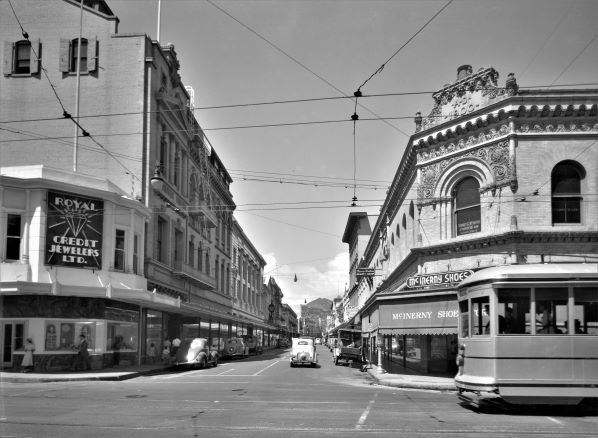

WHAT HAPPENED TO FORT STREET?

Even before World War II, although Fort Street retailing was thriving, parking for private cars was already a problem. The City & County of Honolulu addressed this situation by opening the first downtown public parking lots, equipped with parking meters, in the early 1950s. In the early ‘60s, multi-floor parking structures were built on these same sites.
But even this solution could not compete with shopping centers, which began appearing in the early 1950s. Ample free parking was too convenient for most people to bother with congested downtown Honolulu. The opening of Ala Moana Center in August 1959 with thousands of wide parking spaces was the beginning of the end of Fort Street as the go-to location for shopping. (DeSoto Brown Collection)
But even this solution could not compete with shopping centers, which began appearing in the early 1950s. Ample free parking was too convenient for most people to bother with congested downtown Honolulu. The opening of Ala Moana Center in August 1959 with thousands of wide parking spaces was the beginning of the end of Fort Street as the go-to location for shopping. (DeSoto Brown Collection)
FORT STREET MALL BEGINS
Fort Street by the 1960s was no longer Honolulu’s prime shopping destination. Parking was limited and cost money, the narrow sidewalks were crowded, as this view from November 1964 shows, and most merchandise could be purchased more easily at shopping centers. (Irving Rosen, Bishop Museum Archives)
Starting in the 1950s, various US cities had remodeled their main shopping streets into pedestrian malls. This concept had been done temporarily on Fort Street for special events, usually the annual Aloha Week celebration, as this picture from 1951 shows. Here, a temporary low wall of cement bricks encloses a display of vanda orchids, with full-sized areca palms placed nearby. These earlier successful closures supported the concept of permanently altering Fort Street, which finally began in June 1968. (Bishop Museum Archives)
Starting in the 1950s, various US cities had remodeled their main shopping streets into pedestrian malls. This concept had been done temporarily on Fort Street for special events, usually the annual Aloha Week celebration, as this picture from 1951 shows. Here, a temporary low wall of cement bricks encloses a display of vanda orchids, with full-sized areca palms placed nearby. These earlier successful closures supported the concept of permanently altering Fort Street, which finally began in June 1968. (Bishop Museum Archives)

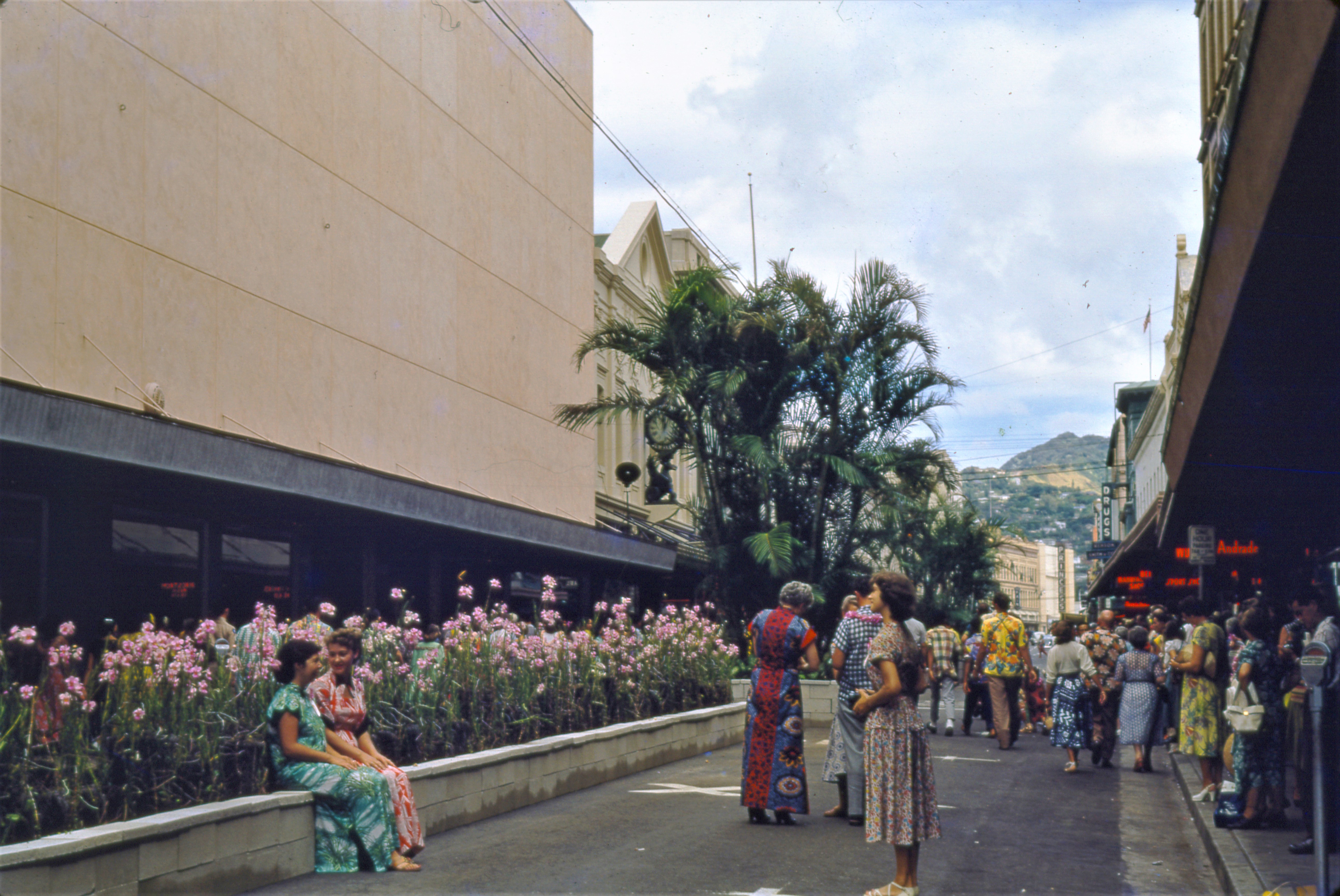
FORT STREET MALL COMPLETED


A ceremony to mark the start of the Fort Street Mall on June 1, 1968 involved multiple male government and business leaders, each man operating a jackhammer (with varying degrees of skill) to start the removal of the street’s asphalt pavement. The official dedication of the completed mall happened on February 22, 1969, with thousands of onlookers in attendance.
The process was not merely to take out sidewalks and pavement, but to add amenities like benches, fountains, shrubs and trees, and special light fixtures. The latter structures, along with substantial trellises for vines, were made of concrete in the popular Brutalist style of that time. Most of these original features are gone today.
The process was not merely to take out sidewalks and pavement, but to add amenities like benches, fountains, shrubs and trees, and special light fixtures. The latter structures, along with substantial trellises for vines, were made of concrete in the popular Brutalist style of that time. Most of these original features are gone today.
FORT STREET MALL IN DECLINE
For some years Fort Street Mall was active with pedestrians, both shoppers as well as office and business workers. The play structure in front of the Kress store was used by kids, while lunchtime performers attracted onlookers, as these 1970s photos show.
But over time, retailers moved to new locations or just closed down, and after COVID many office workers shifted to reduced schedules or just working from home. Fort Street today is mostly unoccupied; the Mall unfortunately only put off the process of decline. The future can’t be predicted with certainty, but we do know that cities never stop evolving. Declines are often followed by rejuvenations. (Photo: DeSoto Brown)
But over time, retailers moved to new locations or just closed down, and after COVID many office workers shifted to reduced schedules or just working from home. Fort Street today is mostly unoccupied; the Mall unfortunately only put off the process of decline. The future can’t be predicted with certainty, but we do know that cities never stop evolving. Declines are often followed by rejuvenations. (Photo: DeSoto Brown)

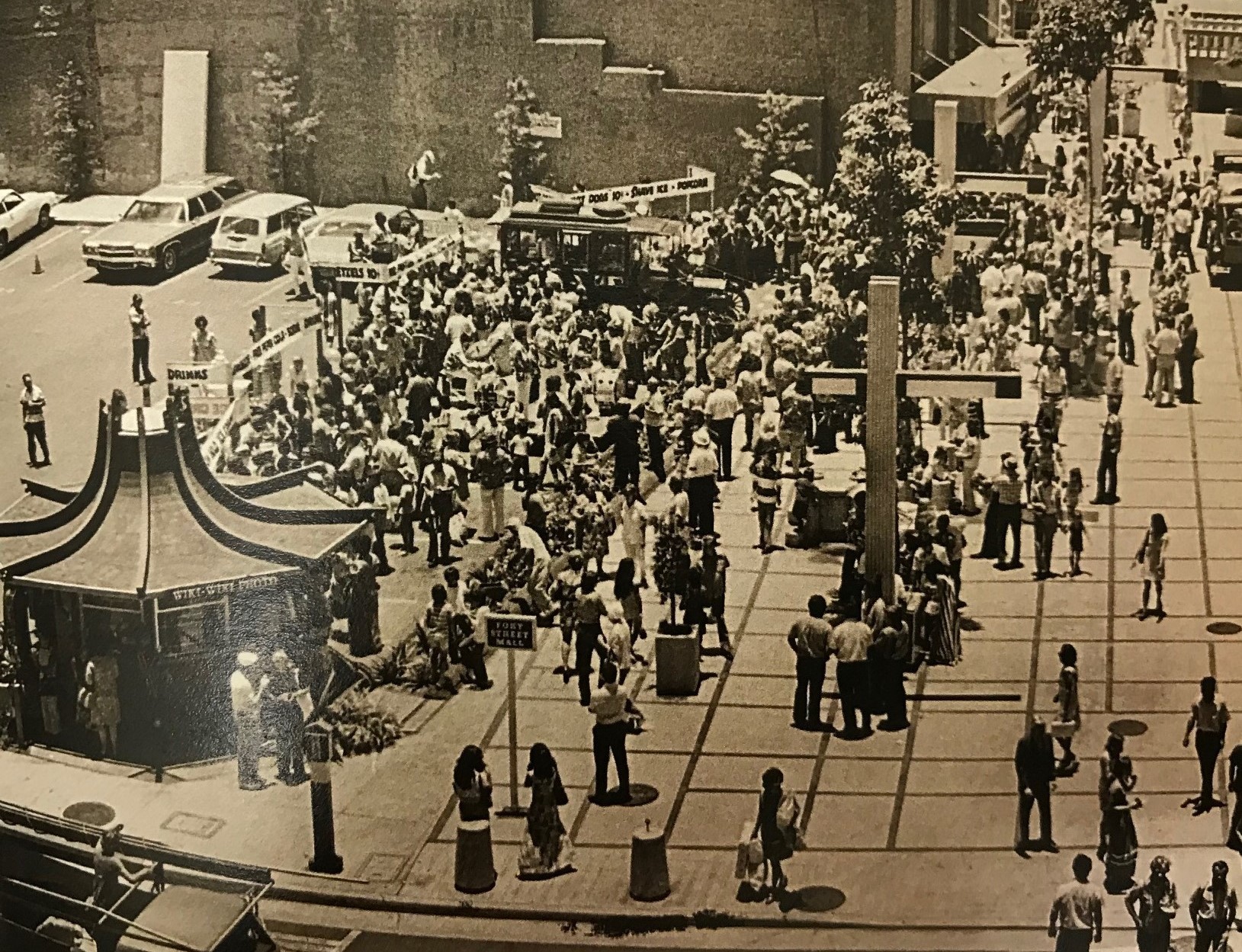
FORT STREET MALL IN DECLINE


Changes on Fort Street, seen from the same location near Beretania Street, with Our Lady of Peace Cathedral on the left: 1941, with vehicle traffic, and 1969, after the opening of the Fort Street Mall. (Left, DeSoto Brown Collection).